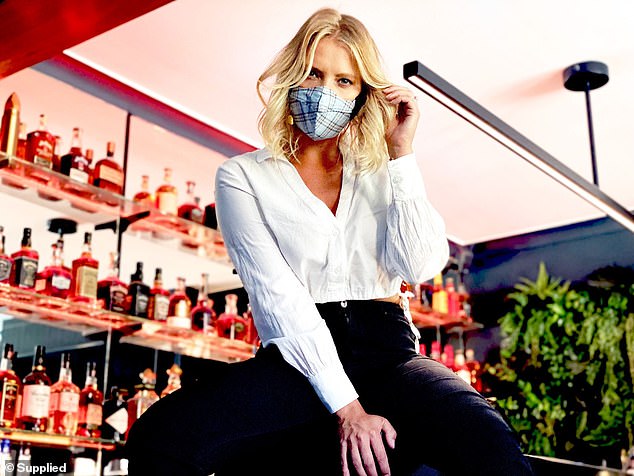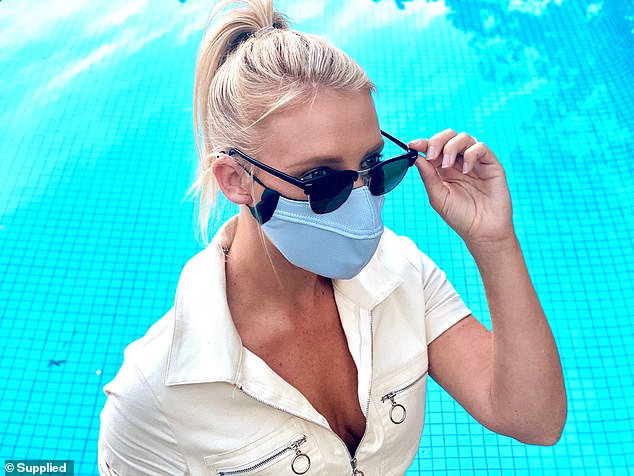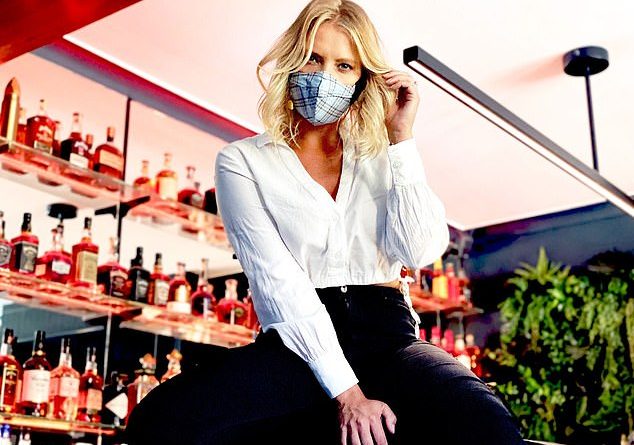Wearing a face mask does not have to be an uncomfortable experience leading to breakouts, fogged glasses and sore ears.
Two experts have had their say on mask use, after it became mandatory for all residents of greater Sydney, including the Blue Mountains, Central Coast and Wollongong to wear them this week.
The recent outbreaks in Sydney’s Northern Beaches and some western suburbs led to the new restrictions – and people who refuse to wear a mask will be fined $200.
Wearing a face mask does not have to be an uncomfortable experience leading to breakouts, fogged glasses and sore ears – experts say
Entrepreneur Cecilia Li, who designed a face mask for the pandemic, has revealed how to wear them for maximum comfort
Entrepreneur Cecilia Li, who designed a face mask for the pandemic, and a NSW Health worker who wishes to remain anonymous revealed their tips.
Ms Li’s top priority with masks is getting people to wear them correctly to avoid discomfort.
She says if you find it difficult breathing in a mask then you might be wearing the wrong kind for you.
‘Choose a mask made from breathable fabrics such as good quality 100% cotton, bamboo or performance polyester which is more breathable,’ Ms Li said.
She also recommends using essential oils like peppermint or lavender with the mask to make it easier to breathe.
It is important your mask fit properly around the bridge of your nose, otherwise your glasses may fog up more
HOW TO WEAR MY MASK TO MAKE IT MORE COMFORTABLE?
If you have trouble breathing with a mask on?
1. Choose a mask made from breathable fabrics such as good quality 100% cotton, bamboo or performance polyester which is more breathable.
2. Use essential oils such as peppermint or lavender oil at the base of the mask to help with comfort and ease your breathing.
If it is too hot to wear a mask?
1. Choose masks that are made from cooling moisture wicking fabrics that are suitable for Australian weather – cotton is breathable but is not quick drying so can create extra heat after wearing for a long time.
3. Choose breathable fabrics that allow for better airflow.
4. If you have long hair, tie it back in a ponytail.
5. Wear the correct sized mask for your face shape.
What if my ears hurt because of the loops?
1. Instead of the more common elastic ear loops, use a mask that has adjustable ear straps.
2. Choose a mask with soft flexible and thinner elastic straps.
What if wearing a mask makes my glasses fog up?
1. Choose a mask that is the correct size for your face shape. A loose-fitting mask lets more of your warmed breath escape from the top of the mask, fogging up your glasses.
2. For a snug fit, try a mask with both adjustable ear loops and a bendable nose piece.
3. Place a facial tissue inside your mask to absorb some of the moisture from your warm breath and reduce the fog.
4. Try anti-fog sprays of your lenses.
What if wearing a mask is causing me to break out?
1. Avoid use of heavy foundation which can clog your pores.
2. Moisturise your skin, especially in the areas prone to irritation from the mask rubbing against your skin.
3. Choose a mask that sits away from your nose and cheeks to minimise the fabric rubbing against your face.
4. Choose a mask that has antibacterial properties such as nanosilver to minimise bacterial growth on the surface.
5. Wash your face before and after wearing a mask.
SOURCE: Cecilia Li Novw Masks
If your ears hurt when you wear a mask then it is also important to fix the problem, according the mum-of-two.
‘Instead of the more common elastic ear loops, use a mask that has adjustable ear straps,’ she said.
She also recommends people who wear glasses pay attention to the way their mask fits along the bridge of their nose.
This will minimise the amount of hot air released, and in turn how much your glasses fog up.
Essential oils, like peppermint, can help people to breathe easily when wearing a mask
WHAT ARE THE TOP TIPS TO KEEPING MYSELF AND OTHERS SAFE WHILE WEARING A MASK?
Masks currently have to be worn inside across NSW. A fine of $200 is payable for those caught out. The NSW Health worker says masks are an added precaution, but hand hygiene and social distancing should not be forgotten.
Surgical Masks:
1- Surgical masks have two sides, a white side and a blue side. The blue side MUST be showing on the outside.
2- The surgical mask also has a top and a bottom. However, if wearing the mask correctly, you should feel a wire on the top. This is so you can mould the mask to the shape of your nose.
3- Ideally, wear them for a maximum of four hours – If they become wet or dirtied in any way, replace them immediately.
4- Try to avoid touching the mask – you are potentially spreading germs to yourself and others.
5- They should ideally cover as far under your chin as it allows.
6- When taking of masks, perform hand hygiene before and take off from the straps (the off from the back of your ears) and then immediately dispose of mask. Then perform hand hygiene immediately afterwards. It seems much easier pulling from the front, but then you are spreading germs.
While the health worker wants people to stay safe, maintain hygiene and understand basic ‘do’s and don’ts’ of mask wear.
‘It is so important that we emphasise social distancing and hand hygiene. Masks have been introduced as an additional measure,’ she said.
She told Daily Mail Australia the way the mask fits is imperative, and explained it should go from the bridge of your nose all the way under your chin.
She also said masks need to be changed every four hours, if they are wet or ‘soiled’ or if you take them off for any reason.
Even the washable masks need to be swapped if they have been removed. As touching them has the potential to spread any virus on the mask elsewhere.
This could infect you if it is on the outside, or lead to you infecting others if you have the disease.
WHAT ARE THE CURRENT RESTRICTIONS IN NSW?
From Monday, people living in Sydney, the Blue Mountains, Wollongong and the Central Coast will be fined if they are caught in public not wearing a face mask.
It was previously thought that masks had to be worn in very limited setting.
But on Sunday, officials explained masks must be worn inside all shopping centres, in places of worship, hair and beauty salons, cinemas, post offices and banks.
Bank branches, tanning salons, waxing salons, spas, tattoo parlours, betting agencies and gaming lounges are also included.
Hospitality staff will also be required to wear masks.
If you take public transport you must wear a mask when you are in a vehicle or vessel being used to provide a public transport service, including a taxi or a rideshare service.
You must also wear a mask when you are at a public transport waiting area which includes:
The station area and platform of a passenger railway or light rail station, a ferry wharf, a bus stop or light rail stop, including any area where persons queue or gather when waiting at the stop and at a taxi rank.
The new restriction will be introduced from 1am on Monday and also applies to other vulnerable facilities like disability accommodation and prisons, chief health officer Jeannette Young said on Sunday.
SOURCE: NSW Health
Share or comment on this article:







